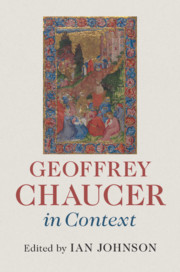Book contents
- Geoffrey Chaucer in Context
- Geoffrey Chaucer in Context
- Copyright page
- Contents
- Illustrations
- Contributors
- Abbreviations
- Introduction
- Part I Chaucer as Context
- Part II Books, Discourse and Traditions
- Part III Humans, the World and Beyond
- Chapter 19 Chaucer’s God
- Chapter 20 Holiness
- Chapter 21 Secularity
- Chapter 22 The Self
- Chapter 23 Women
- Chapter 24 Sex and Lust
- Chapter 25 Animals in Chaucer
- Part IV Culture, Learning and Disciplines
- Part V Political and Social Contexts
- Part VI Chaucer Traditions
- Further Reading
- Index
Chapter 25 - Animals in Chaucer
from Part III - Humans, the World and Beyond
Published online by Cambridge University Press: 24 June 2019
- Geoffrey Chaucer in Context
- Geoffrey Chaucer in Context
- Copyright page
- Contents
- Illustrations
- Contributors
- Abbreviations
- Introduction
- Part I Chaucer as Context
- Part II Books, Discourse and Traditions
- Part III Humans, the World and Beyond
- Chapter 19 Chaucer’s God
- Chapter 20 Holiness
- Chapter 21 Secularity
- Chapter 22 The Self
- Chapter 23 Women
- Chapter 24 Sex and Lust
- Chapter 25 Animals in Chaucer
- Part IV Culture, Learning and Disciplines
- Part V Political and Social Contexts
- Part VI Chaucer Traditions
- Further Reading
- Index
Summary
Animals are to be found in many places and modes in Chaucer’s work. They feature as similes (Palamon and Arcite in the Knight’s Tale are compared to lion, tiger and boar), star in fables (the Nun’s Priest’s Tale) or are simply themselves, like the cow of the lyric Truth, or the spider of the Treatise on the Astrolable. Heeding Lisa Kiser’s caution that animals in literature risk being absorbed into the human mindset, this essay explores some of the animals (and insects) found in Chaucer, and, by reading them alongside Isidore of Seville’s definition of ‘beast’, seeks to demonstrate how they resist such absorption and instead steer our attention to aspects of daily life or concepts we are liable to overlook. Animals may act as vehicles for our thoughts, but sometimes they carry us to places we did not consciously intend.
- Type
- Chapter
- Information
- Geoffrey Chaucer in Context , pp. 209 - 216Publisher: Cambridge University PressPrint publication year: 2019

